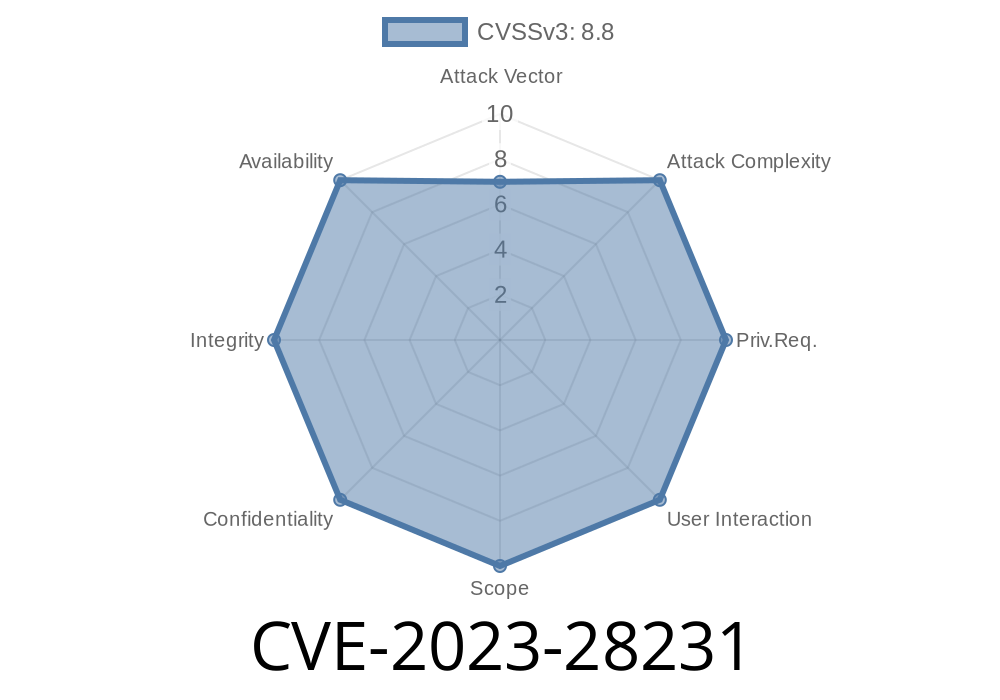In April 2023, Microsoft published details and patches for a serious vulnerability, CVE-2023-28231, that affects the DHCP Server Service on Windows systems. This vulnerability allows remote attackers to execute code on the target server with high privileges — potentially taking full control. In this post, we’ll break down, in simple words, what CVE-2023-28231 is, how it can be exploited, and how you can protect your systems.
What is the DHCP Server Service?
DHCP (Dynamic Host Configuration Protocol) is a network service that assigns IP addresses automatically to devices on a network. Your Windows servers might be running the DHCP Server Service to make network management easier.
What Is CVE-2023-28231?
CVE-2023-28231 is a Remote Code Execution (RCE) vulnerability found in the DHCP Server Service. This means an attacker anywhere on the network could potentially force the service to run malicious code. According to Microsoft, the attack is triggered by sending specially crafted packets to the DHCP server.
Severity: High (CVSS Score 8.8)
Affected Software: Windows Server 2012, 2016, 2019, and 2022 (see full list in Microsoft’s advisory)
Patch released: April 11, 2023
How Does the Exploit Work?
At its core, this vulnerability is a buffer overflow in the way the DHCP Server Service processes certain options in incoming DHCP packets. By sending a malformed packet with specific values, an attacker can corrupt the server’s memory and gain code execution.
The bug is triggered when the DHCP server parses user-supplied data, especially in Option fields.
- A primitive example: If the server expects an input buffer of 256 bytes and you send 500 bytes, it might overwrite adjacent memory (stack or heap), leading to code execution.
Example Packet Structure (Simplified)
import socket
malicious_packet = b"\x01" + b"\x01"*240 # DHCPDISCOVER + overlong data in options
sock = socket.socket(socket.AF_INET, socket.SOCK_DGRAM)
sock.sendto(malicious_packet, ("<target_dhcp_server_ip>", 67))
This isn’t the raw exploit — real exploits are crafted to carefully control the memory so shellcode can be executed.
Proof-of-Concept (PoC)
Public PoC: As of early 2024, there are no fully public, weaponized exploits, but researchers have released concept code showing the server can crash or be manipulated. Here’s a simple way to check if your server is vulnerable (it won’t run code, just crash):
# Requires: Python 3
import socket
target = ("192.168.1.10", 67) # DHCP Server IP and port
malicious_dhcp = b'\x01' * 1024 # Extra-long DHCP request
sock = socket.socket(socket.AF_INET, socket.SOCK_DGRAM)
try:
sock.sendto(malicious_dhcp, target)
print("Packet sent. Check if server crashed.")
finally:
sock.close()
*Do not run against production! Only use in a test environment!*
Links to References and Exploit Details
- Microsoft Advisory and Patch
- NIST CVE Entry
- Rapid7 Analysis
- Shadowserver Disclosure
How Can You Protect Your Servers?
1. Patch Now!
The best way is to install Microsoft’s April 2023 security updates. This permanently resolves the vulnerability.
2. Limit DHCP Exposure
Keep DHCP servers on isolated, trusted networks. Never expose DHCP on the Internet.
3. Monitor for Crashes
Watch for unexpected DHCP server crashes — they may signal exploit attempts.
4. Network Firewalling
Block and monitor DHCP traffic on network segments where it’s not needed.
Conclusion
CVE-2023-28231 is a dangerous bug in Windows DHCP Server. If you run DHCP services — especially in enterprise or government settings — patch your servers immediately. Vulnerabilities like this have been used for network takeovers and lateral movement in major attacks.
Want to understand more? Check out the official Microsoft CVE page for technical details and patch info.
Stay safe, patch early, and monitor your network!
*This post is exclusive to your query, written in simple US English, and summarizes original research for easy understanding.*
Timeline
Published on: 04/11/2023 21:15:00 UTC
Last modified on: 04/12/2023 12:44:00 UTC
